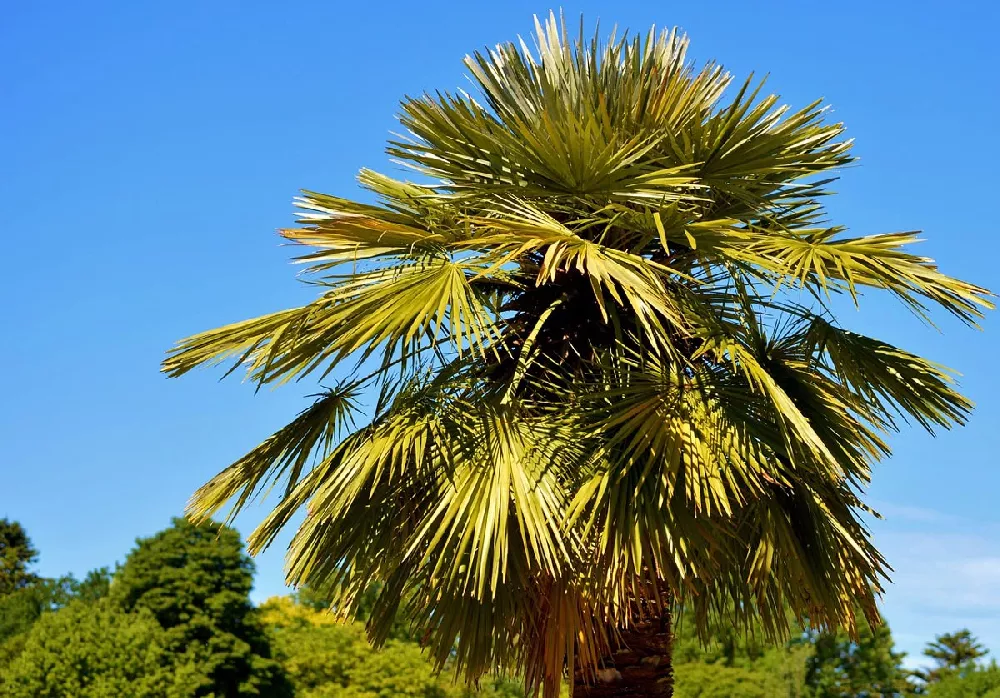- Home >
- Houseplants >
- Fishtail Palm Trees
Fishtail Palm Trees for Sale - Buying & Growing Guide
The fishtail palm tree is the ideal plant to grow if you want a palm tree that is easy to care for and will show fantastic foliage. This plant, known scientifically as Caryota mitis, has leaves that deviate from the standard palm frond form. Rather than long and feathery fronds, this species features fishtail-shaped leaves, as the name suggests. The fishtail palm tree is also very easy to care for and will withstand some harsh conditions, including strong winds and the occasional frost.
- Unique fishtail-shaped leaves are unlike those of any other palm tree.
- Shows a surprising ability to survive light frosts.
- Requires minimal upkeep while resisting wind damage and drought.
Enter your zip code to find nearby stores that may carry this plant.
Plant Care
Sunlight

Full or partial shade when growing outdoors. Indirect light in indoor settings.
Watering
Water weekly from spring through late summer. Reduce to monthly watering in winter.
Fertilizing

Fertilize once every four months. Use a fertilizer specified for palm trees.
Planting and Care
Planting instructions
The fishtail palm adapts to a relatively wide range of sun exposure, growing well in both full sunlight and partial shade conditions. When you plant this tree, be sure to dig a hole as deep as the root ball is tall and twice as wide.
Provide at least 6 feet of open space around this plant when growing it outside. When growing a fishtail palm indoors, place it where it can receive indirect light. Fishtail palm trees will perform best with well-draining soil, whether indoors or outdoors.
Watering and nutrients
Fishtail palm trees require plenty of water. You should give this plant water about once per week during the growing season. You can reduce your watering frequency to once per month in the winter.
Rich soil will also help this plant thrive. Try amending your soil with peat or some other organic material to give your fishtail palm all the nutrients it needs. Fertilization should take place about once every four months. When you fertilize, just about any granular palm tree fertilizer should work well.
Pruning
Fishtail palm trees do not need regular pruning. You can often neglect to prune entirely, and this plant will continue to survive and put forth healthy new growth. However, you may wish to prune your fishtail palm tree to manage its size.
If you choose to prune your fishtail palm, be highly selective. Choose individual stalks and remove them one at a time. When pruning, it is best to use sterile tools and to make clean cuts to encourage the plant to heal quickly.
Pests, diseases, and animals
Several pests and diseases can afflict the fishtail palm, including mites, spider mites, and scale insects. In addition, fishtail palms can also have issues with fungus and bacteria. If a fungal or bacterial infection occurs, you’ll notice that this plant’s leaves will show spots and change colors.
The combination of pest and disease problems is a severe threat to fishtail palm tree populations worldwide. Thankfully, through proper care and watering tactics, it’s possible to reduce the odds these challenges will occur.
Achieving maximum results
Never perform overhead watering for fishtail palm trees. Getting the foliage too wet is one of the primary reasons why insects and diseases occur in this species. Watering in the morning is also a wise tactic, as it gives the sun plenty of time to dry any moisture on this plant’s leaves throughout the day.
You should also know that a few distinct species share the name fishtail palm. All of these species belong to the same genus. But to get the best results, you need to know which species you own and its specific care requirements.
FAQs
What are the different types of fishtail palm tree?
One confusing fact about the name fishtail palm tree is that it can refer to any of a few different palm tree species. While the variety known as Caryota mitis is one of the most popular, species such as Caryota urens, Caryota obtusa, and Caryota no share the same common name. Since these palms belong to the same genus, they often have similar care requirements and growth habits. However, each species may call for different care routines.
Where does the fishtail palm tree come from?
The fishtail palm tree known as Caryota mitis comes from tropical regions of Asia. Its native range includes countries such as China, India, and Vietnam. Today, this plant grows in many locations, including warmer regions of the United States, such as Florida. For those in colder areas, this species remains a viable planting option, as it can do well in indoor locations as well.
How large does the fishtail palm tree grow?
Fishtail palm trees can grow to more than 20 feet tall and can spread to about 35 feet wide at maturity. However, fishtail palm trees also have a moderate growth rate, meaning it may take a while for them to reach their fullest form. In indoor settings, this plant will be much smaller, but in outdoor locations, you may need to use pruning to control this plant's expansion.
Compare Similar Products
You can't add more Product Name - Product size to the cart.
OK









